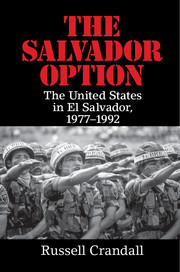Book contents
- Frontmatter
- Dedication
- Epigraph
- Contents
- List of Figures
- List of Organizations
- Acknowledgments
- 1 Introduction
- PART ONE EL SALVADOR IN THE COLD WAR
- PART TWO JIMMY CARTER
- 7 Revolution and Counterinsurgency in Guatemala
- 8 Mass Organizations
- 9 Carter Arrives
- 10 Carter and the Sandinista Revolution in Nicaragua, 1979
- 11 An October Coup
- 12 Carter Engages Salvador
- 13 Archbishop Romero
- 14 Land
- 15 The American Churchwomen
- 16 Arming the Rebels
- 17 Guerrilla Final Offensive, January 1981
- 18 Death Squads
- PART THREE RONALD REAGAN
- PART FOUR GEORGE H. W. BUSH
- PART FIVE POSTWAR
- Notes
- Bibliography
- Index
7 - Revolution and Counterinsurgency in Guatemala
from PART TWO - JIMMY CARTER
Published online by Cambridge University Press: 05 June 2016
- Frontmatter
- Dedication
- Epigraph
- Contents
- List of Figures
- List of Organizations
- Acknowledgments
- 1 Introduction
- PART ONE EL SALVADOR IN THE COLD WAR
- PART TWO JIMMY CARTER
- 7 Revolution and Counterinsurgency in Guatemala
- 8 Mass Organizations
- 9 Carter Arrives
- 10 Carter and the Sandinista Revolution in Nicaragua, 1979
- 11 An October Coup
- 12 Carter Engages Salvador
- 13 Archbishop Romero
- 14 Land
- 15 The American Churchwomen
- 16 Arming the Rebels
- 17 Guerrilla Final Offensive, January 1981
- 18 Death Squads
- PART THREE RONALD REAGAN
- PART FOUR GEORGE H. W. BUSH
- PART FIVE POSTWAR
- Notes
- Bibliography
- Index
Summary
The duty of a revolutionary is to make revolution.
– Che Guevara, 1962There are some indications that Fidel Castro is planning to increase his support of the Guatemalan insurgency, perhaps to the point of dispatching a small force of guerrillas now undergoing training in Cuba.
– U.S. classified intelligence report, 1960sIf you [the Guatemalan people] are with us, we'll feed you; if not, we'll kill you.
– Guatemalan General Rios MonttThis chapter explores in particular depth the significant but chilling case of Marxist insurgency and military counterinsurgency in Guatemala – and the American reaction to it. This episode is especially salient as Guatemala's internal war, unlike the war in El Salvador, took place largely without U.S. involvement. It thus provides an interesting historical counterfactual in terms of what could have happened in El Salvador had the United States not gotten involved.
More specifically, starting during the Carter administration in the late 1970s, Washington lost influence over the Guatemalan state, especially the military. Contrary to what is often assumed, the Guatemalan government suspended American military assistance, not the other way around. This unprecedented act ensured that U.S. military trainers and materiel did not enter into Guatemala, as was the case in El Salvador. Yet, the absence of American advisors did not prevent the Guatemalan military from launching a genocidal, scorched-earth counterinsurgency campaign against Marxist guerrillas – or, more specifically, against the civilian and desperately poor Mayan population believed to be supporting these guerrillas.
Six years after the CIA-hatched Operation PBSUCCESS in 1954, junior army officers in Guatemala attempted a coup against the ruling authoritarian regime headed by General José Miguel Ramón Ydígoras, who had taken power after Washington-backed strongman Castillo Armas had been murdered. Interestingly, the revolting officers were upset that the CIA was using Guatemala to train anti-Castro Cuban exiles for the Bay of Pigs operation. When the uprising foundered, a few of these officers retreated to the hills to organize a guerrilla insurgency, which they believed would be the surest avenue to radical social and economic change. Not surprisingly, they soon established contact with Havana.
- Type
- Chapter
- Information
- The Salvador OptionThe United States in El Salvador, 1977–1992, pp. 79 - 89Publisher: Cambridge University PressPrint publication year: 2016



